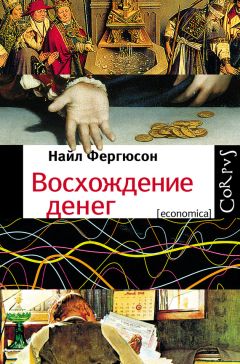Ниал Фергюсон - Восхождение денег
41 S. Diamond (ed.), A Casual View of America: The Home Letters of Salomon de Rothschild, 1859–1861 (London, 1962).
42 Cm.: Rudolf Glanz, The Rothschild Legend in America’, Jewish Social Studies, 19 (1957). Pp. 3-28.
43 Marc D. Weidenmier, The Market for Confederate Cotton Bonds’, Explorations in Economic History, 37 (2000). Pp. 76–97. См. его же работу: Turning Points in the U.S. Civil War: Views from the Grayback Market’, Southern Economic Journal, 68, 4 (2002). Pp. 875–890.
44 Cm.: W O. Henderson, The Lancashire Cotton Famine: 1861–1865 (Manchester, 1934); Thomas Ellison, The Cotton Trade of Great Britain (NewYork, 1968 [1886]).
45 Marc D. Weidenmier, ‘Comrades in Bonds: The Subsidized Sale of Confederate War Debt to British Leaders’, Claremont McKenna College Working Paper (2/2003).
46 Richard Roberts, Schroders: Merchants and Bankers (Basingstoke, 1992). P. 66.
47 Richard С. K. Burdekin and Marc D. Weidenmier, ‘Inflation is Always and Everywhere a Monetary Phenomenon: Richmond vs. Houston in 1864’, American Economic Review, 91, 5 (12/2001). Pp. 1621–1630.
48 Richard Burdekin and Marc Weidenmier, ‘Suppressing Asset Price Inflation: The Confederate Experience, 1861–1865’, Economic Inquiry, 41, 3 (7/2003), 420–432. Cm.: Eugene M. Lerner, ‘Money, Prices and Wages in the Confederacy, 1861–1865’, Journal of Political Economy, 63, 1 (2/1955). Pp– 20–40.
49 Frank Griffith Dawson, The First Latin American Debt Crisis (London, 1990).
50 Kris James Mitchener and Marc Weidenmier, ‘Supersanctions and Sovereign Debt Repayment’, NBER Working Paper 11472 (2005).
51 Niall Ferguson and Moritz Schularick, The Empire Effect: The Determinants of Country Risk in the First Age of Globalization, 1880–1913 Journal of Economic History, 66, 2 (6/2006). Pp. 283–312.
52 Kris James Mitchener and Marc Weidenmier, ‘Empire, Public Goods, and the Roosevelt Corollary’, Journal of Economic History, 65 (2005). Pp. 658–692.
53 William Cobbett, Rural Rides (London, 1985 [1830]). Pp. 117.
54 Ibid., pp. 34, 53.
55 M. de Cecco, Money and Empire: The International Gold Standard, 1890–1914 (Oxford, 1973).
56 Theo Balderston, ‘War Finance and Inflation in Britain and Germany, 1914–1918’, Economic History Review, 42, 2 (5/1989). Pp. 222–244.
57 Подсчитано с использованием В. R. Mitchell, International Historical Statistics: Europe, 1750-199} (London, 1998. Pp. 358ff.
58 Jay Winter and Jean-Louis Robert (eds.), Capital Cities at War: Paris, London, Berlin 1914–1919, Studies in the Social and Cultural History of Modern Warfare, No. 2 (Cambridge, 1997). P. 259.
59 Gerald D. Feldman, The Great Disorder: Politics, Economy and Society in the German Inflation, 1914–1924 (Oxford / New York, 1997). Pp. 211–254.
60 Elias Canetti, Crowds and Power (New York, 1988). P 186.
61 John Maynard Keynes, A Tract on Monetary Reform, reprinted in Collected Writings, vol. iv (Cambridge, 1971). Pp. 3, 29, 36.
62 John Maynard Keynes, The Economic Consequences of the Peace (London, 1919). Pp. 220–233.
63 Frank Whitson Fetter, ‘Lenin, Keynes and Inflation’, Economica, 44, 173 (2/1977). P 78.
64 William C. Smith, ‘Democracy, Distributional Conflicts and Macroeconomic Policymaking in Argentina, 1983–1989’, Journal of Interamerican Studies and World Affairs, 32, 2 (Summer 1990)/ Pp. 1-42. См. также: Rafael Di Telia and Ingrid Vogel, ‘The Argentine Paradox: Economic Growth and Populist Tradition’, Harvard Business School Case 9-702-001 (2001).
65 Ferguson, World's Banker, ch. 27.
66 Подробнее об этом см.: Gerardo della Paolera and Alan M. Taylor, Straining at the Anchor: The Argentine Currency Board and the Search for Macroeconomic Stability, 1880–1935 (Chicago, 2001).
67 ‘A Victory by Default’, Economist, 3/3/2005.
68 Недавно эта тема обсуждалась в работе: Michael Tomz, Reputation and International Cooperation: Sovereign Debt across Three Centuries (Princeton, 2007).
69 “Великая инфляция” обсуждается сразу в нескольких работах: Fabrice Collard and Harris Delias, ‘The Great Inflation of the 1970s’, Working Paper (1/10/2003); Edward Nelson, ‘The Great Inflation of the Seventies: What Really Happened?’, Federal Reserve Bank of St Louis Working Paper, 2004-001 (1/2004); Allan H. Meltzer, ‘Origins of the Great Inflation’, Federal Reserve Bank of St Louis Review, Part 2 (3–4/2005). Pp. 145-175-
70 Эти одиннадцать рынков – Австралия, Канада, Франция, Германия, Гонконг, Ирландия, Япония, Нидерланды, Швейцария, Великобритания и США. См. Watson Wyatt, ‘Global Pension Fund Assets Rise and Fall’: http://www.watsonwyatt.com/news/press. aspUD = 18579.
71 CNN, 9/7/2000.
72 Testimony of Chairman Alan Greenspan, Federal Reserve Board’s semiannual Monetary Policy Report to the Congress, before the Committee on Banking, Housing, and Urban Affairs, US Senate, 16/2/2005.
III. Пуская пузыри
1 Эта тема хорошо изучена, из недавних работ надо отметить Timothy Guinnane, Ron Harris, Naomi R. Lamoreaux, and Jean-Laurent Rosenthal, Putting the Corporation in its Place’, NBER Working Paper 13109 (5/2007).
2 См. особенно: Robert J. Shiller, Irrational Exuberance (2nd edn., Princeton, 2005).
3 Cm.: Charles P. Kindleberger, Manias, Panics and Crashes: A History of Financial Crises (3rd edn., New York / Chichester / Brisbane / Toronto / Singapore, 1996). Pp. 12–16. В своей работе Киндлебергер отдает должное революционным наработкам Хаймана Мински. Две ключевые работы последнего: Hyman Р. Minsky, ‘Longer Waves in Financial Relations: Financial Factors in the More Severe Depressions’, American Economic Review, 54, 3 (5/1964). Pp. 324–335; ‘Financial Instability Revisited: The Economics of Disaster’, in Hyman P. Minsky (ed.), Inflation, Recession and Economic Policy (Brighton, 1982). Pp. 117–161.
4 Kindleberger, Manias. P 14.
5 ‘The Death of Equities’, Business Week, 13/8/1979.
6 ‘Dow 36,000’, Business Week, 27/9/1999.
7 William N. Goetzmann and Philippe Jorion, ‘Global Stock Markets in the Twentieth Century’, Journal of Finance, 54, 3 (6/1999). Pp. 953–980.
8 Jeremy J. Siegel, Stocks for the Long Run: The Definitive Guide to Financial Market Returns and Long-Term Investment Strategies (New York, 2000).
9 Elroy Dimson, Paul Marsh and Mike Stanton, Triumph of the Optimists: loi Years of Global Investment Returns (Princeton, 2002).
10 Paul Frentrop, A History of Corporate Governance 1602–2002 (Brussels, 2003). Pp. 49–51.
11 Ronald Findlay and Kevin H. O’Rourke, Power and Plenty: Trade, War, and the World Economy in the Second Millennium (Princeton, 2007). P. 178.
12 Frentrop, Corporate Governance. P 59.
13 О противоречиях, которыми изобиловала Голландская республика в эпоху господства капитализма и кальвинизма, писал Саймон Шама в своей книге The Embarrassment of Riches: An Interpretation of Dutch Culture in the Golden Age (New York, 1997 [1987]).
14 John P. Shelton, The First Printed Share Certificate: An Important Link in Financial History’, Business History Review, 39, 3 (Autumn 1965). P 396.
15 Shelton, ‘First Printed Share Certificate’. P 400.
16 Engel Sluiter, ‘Dutch Maritime Power and the Colonial Status Quo, 1585–1641’, Pacific Historical Review, 11, 1 (March 1942). P 33.
17 Ibid., p. 34.
18 Frentrop, Corporate Governance. P 69.
19 Larry Neal, ‘Venture Shares of the Dutch East India Company’, in William N. Goetzmann and K. Geert Rouwenhorst (eds.), The Origins of Value: The Financial Innovations that Created Modern Capital Markets (Oxford, 2005). P 167.
20 Neal, ‘Venture Shares’. P. 169.
21 Schama, Embarrassment of Riches. P 349.
22 Ibid., p. 339.
23 Neal, ‘Venture Shares’ P 169.
24 Frentrop, Corporate Governance. P 85.
25 Ibid., p. 95.
26 Ibid., p.103. См. также Neal, ‘Venture Shares’. P 171.
27 Neal, ‘Venture Shares’. P. 166.
28 Findlay and O’Rourke, Power and Plenty. P. 178.
29 Ibid., p. 179–183. См также: Sluiter, ‘Dutch Maritime Power’. P. 32.
30 Findlay and O’Rourke, Power and Plenty. P. 208.
31 Femme S. Gaastra, ‘War, Competition and Collaboration: Relations between the English and Dutch East India Company in the Seventeenth and Eighteenth Centuries’, in H. V Bowen, Margarette Lincoln and Nigel Ribgy (eds.), The Worlds of the East India Company (Leicester, 2002). P. 51.
32 Gaastra, ‘War, Competition and Collaboration’. P. 58.
33 Ann M. Carlos and Stephen Nicholas, ‘«Giants of an Earlier Capitalism»: The Chartered Trading Companies as Modern Multinationals’, Business History Review, 62, 3 (Autumn 1988). Pp. 398–419.
34 Gaastra, ‘War, Competition and Collaboration’. P. 51.
35 Findlay and O’Rourke, Power and Plenty. P. 183.
36 Ibid., p. 185, figure 4.5.
37 Gaastra, ‘War, Competition and Collaboration’. P. 55.
38 Jan de Vries and A. van der Woude, The First Modern Economy: Success, Failure and Perseverance of the Dutch Economy, 1500–1815 (Cambridge, 1997). P. 396.
39 Andrew McFarland Davis, ‘An Historical Study of Taw’s System’, Quarterly Journal of Economics, 1, 3 (April 1887). P. 292.
40 H. Montgomery Hyde, John Law: The History of an Honest Adventurer (Fondon, 1969). P. 83.
41 Earl J. Hamilton, Trices and Wages at Paris under John Faw’s System’, Quarterly Journal of Economics, 51, 1 (November 1936). P. 43.
42 Davis, ‘Faw’s System’. P. 300.
43 Ibid., p. 305.
44 Thomas E. Kaiser, ‘Money, Despotism, and Public Opinion in Early Eighteenth-Century Finance: John Faw and the Debate on Royal Credit’, Journal of Modern History, 63, 1 (March 1991). P. 6.
45 Max J. Wasserman and Frank H. Beach, ‘Some Neglected Monetary Theories of John Faw’, American Economic Review, 24,4 (December 1934). P. 653.
46 James Macdonald, A Free Nation Deep in Debt: The Financial Roots of Democracy (New York, 2003). P. 192.
47 Kaiser, ‘Money’. P. 12.
48 Ibid., p. 18.
49 Hamilton, ‘Prices and Wages’. P. 47.
50 Davis, ‘Faw’s System’. P. 317.
51 Antoin E. Murphy, John Law: Economic Theorist and Policy-Maker (Oxford, 1997). P. 233.
52 Hamilton, ‘Prices and Wages’. P. 55.
53 Murphy, John Law. P. 201.
54 Ibid., p. 190.
55 Cm.: Tarry Neal, The Rise of Financial Capitalism: International Capital Markets in the Age of Reason (Cambridge, 1990). P. 74.
56 Kaiser, ‘Money’. P. 22.
57 О том, как английские спекулянты бежали из Парижа в ноябре и декабре, рассказывает Ларри Нил: Financial Capitalism. Р. 68.
58 Murphy, John Law. P. 213.
59 Ibid., p. 205.
60 Lord Wharncliffe (ed.), The Letters and Works of Lady Mary Wortley Montagu (Paris, 1837). P. 321.
61 Earl J. Hamilton, ‘John Law of Lauriston: Banker, Gamester, Merchant, Chief?’, American Economic Review, 57, 2 (May 1967). P. 273.
62 Murphy, John Law. Pp. 201–202.
63 Hamilton, ‘John Law’. P. 276.
64 Murphy, John Law. P. 239. См. также: Hamilton, ‘Prices and Wages’. P. 60.
65 Kaiser, ‘Money’. Pp. 16, 20.
66 Ibid., p. 22.
67 Murphy, John Law. P. 235.
68 Ibid., p. 250.
69 Hyde, Law. P. 159.
70 Schama, Embarrassment of Riches. Pp. 366ff.
71 Ibid., pp. 367!!.
72 По-разному раскрывают эту историю работы: Neal, Financial Capitalism. P. 89–117; Edward Chancellor, Devil Take the Hindmost; A History of Financial Speculation (London, 1999). Pp. 58–95.
73 Chancellor, Devil Take the Hindmost. P. 64.
74 Ibid., p. 84.
75 Neal, Financial Capitalism. Pp.. 90, liiff. Как заметил Нил, инвестор, который приобрел бы акции компании Южных морей в начале 1720-го и продал их в конце того же года, получил бы 56 % годовых (даже с учетом лопнувшего пузыря).
76 Julian Hoppitt, The Myths of the South Sea Bubble’, Transactions of the Royal Historical Society, 12 (2002). Pp. 141–165.
77 Tom Nicholas, ‘Trouble with a Bubble’, Harvard Business School Case N9-807-146 (28.2.2007). P. 1.
78 William L. Silber, When Washington Shut Down Wall Street: The Great Financial Crisis of 1914 and the Origins of America's Monet-ary Supremacy (Princeton, 2006).
79 Niall Ferguson, ‘Political Risk and the International Bond Market between the 1848 Revolution and the Outbreak of the First World War’, Economic History Review, 59, 1 (February 2006). Pp. 70-112.




